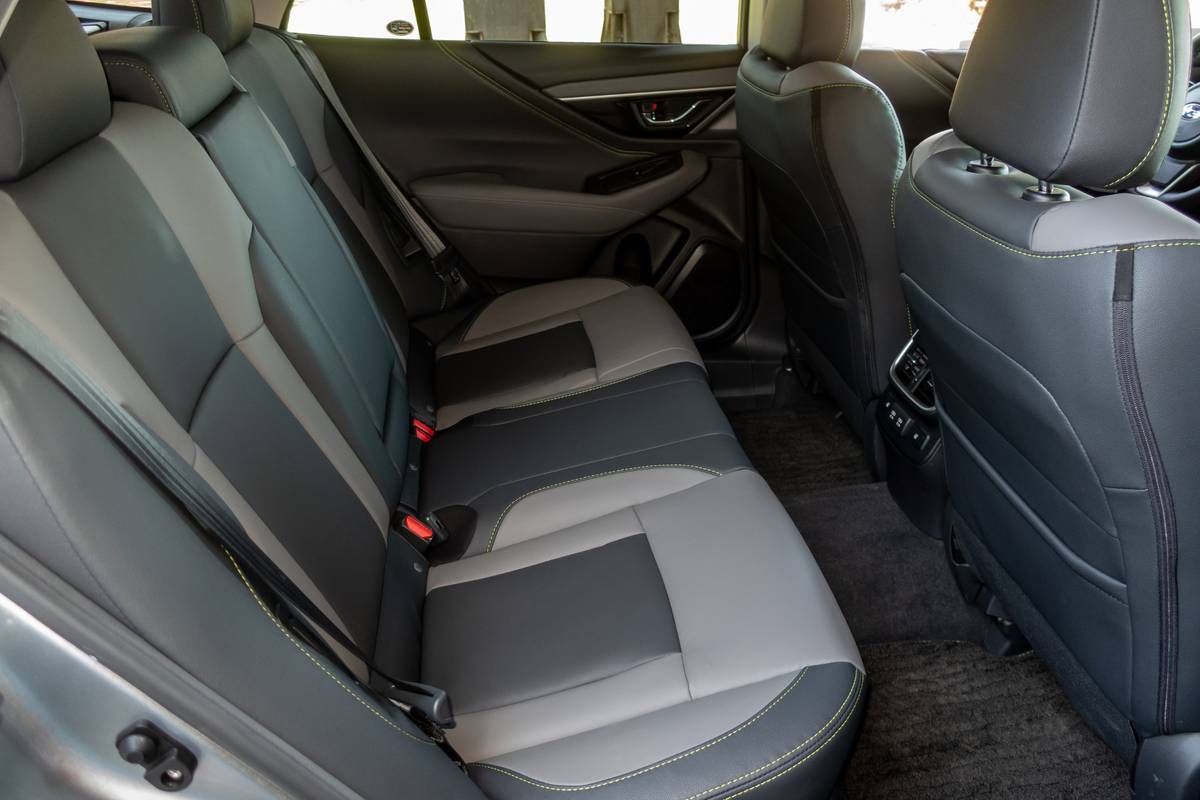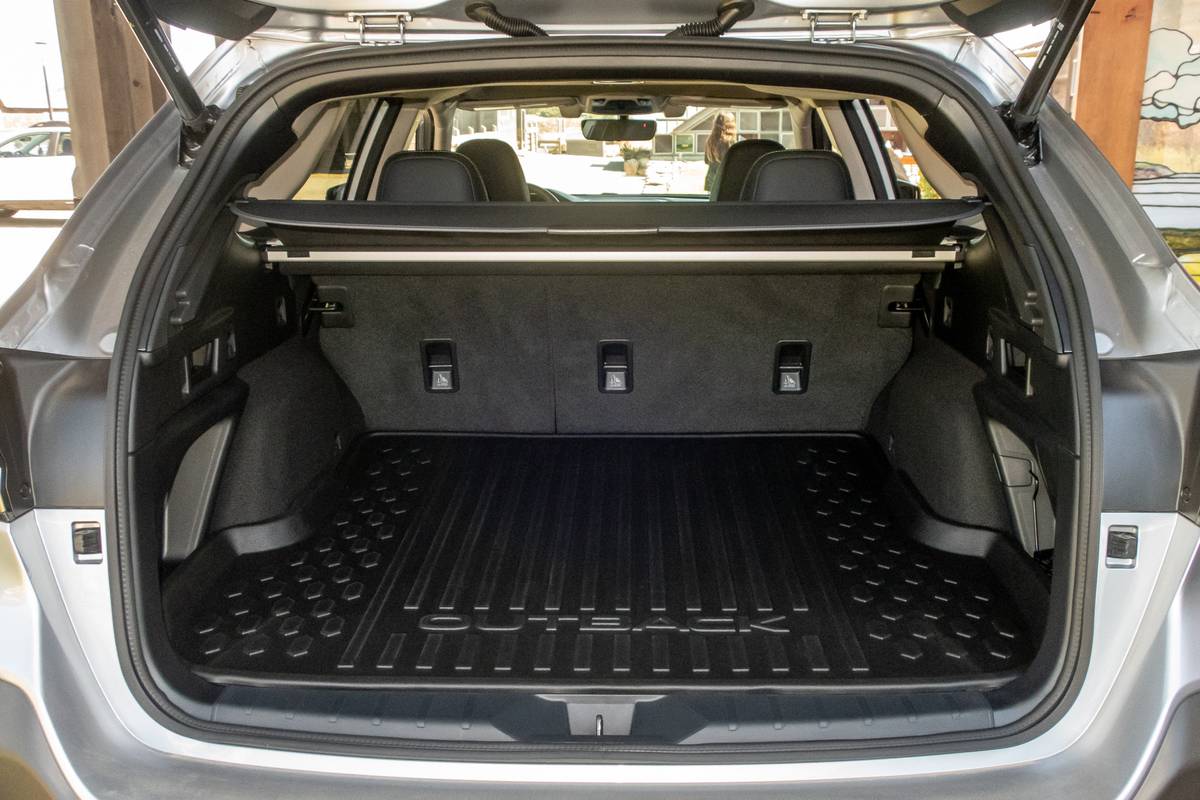2020 Subaru Outback First Drive: Your Budget Volvo CrossCountry Has Arrived


When Subaru took its Legacy wagon, jacked it up, slapped on plastic cladding and gave it an outdoorsy name, nobody imagined the Subaru Outback would become Subaru’s most beloved, best-selling model two decades later. I drove the all-new sixth-generation 2020 Outback in Northern California at a Subaru media event, and all I can say is this: If you’re a fan of the current Outback, wait till you get behind the wheel of this one — you’re going to absolutely love it. (Per our ethics policy, Cars.com pays for its own lodging and airfare at such automaker-sponsored events.)
Related: 12 New Can’t-Miss Things About the 2020 Subaru Outback
- ${price_badge()}
- ${ami_badge()}
- ${battery_badge()}${ev_report_link()}
- ${hot_car_badge()}
- ${award_badge()}
- ${cpo_badge()}
${price_badge_description}
${ami_badge_description}
The EV Battery Rating is based on this vehicle's current expected range relative to the vehicles expected range when new. ${battery_badge_text}
Certified cars are manufacturer warrantied and typically go through a rigorous multi-point inspection.
This car is likely to sell soon based on the price, features, and condition.
${award_blurb}
${award_two_blurb}
Shop the 2020 Subaru Outback near you


Looks the Same, Feels Completely Different
The redesigned 2020 Outback barely looks different from the outgoing model, with a few slightly updated, vaguely evolutionary design cues in its chunky, hiking-bootlike styling. But fiercely loyal Outback customers don’t care — they like the way the Outback looks just fine, with the old one selling in record numbers even as the new one is on the way in just a few weeks.
To be fair, the design works. Selective use of high-strength steel keeps the pillars thin for excellent outward visibility. The beltline remains low for a commanding view over the hood or to the sides. And the hiking boot analogy really does work for the Outback, with its chunky plastic lower and sleek, colorful upper, just like what its customers tend to wear on their feet. But the magic of the new 2020 Outback isn’t in the way it looks, it’s in how it drives.
Punching Above Its Class
Thanks to its all-new platform, torsional rigidity is up an almost unbelievable amount (70 percent), which gives the engineers a steadfast platform on which to build the suspension, steering, and braking systems. Put simply: The Outback drives like a premium luxury vehicle. Think Audi A6 or Volvo V90 wagon instead of two-row SUV competitors like the Chevrolet Blazer, Hyundai Santa Fe or Jeep Grand Cherokee. The body control is absolutely exceptional, with ride and handling feeling sophisticated in a way I haven’t experienced in a Subaru product before. The Subaru Ascent three-row SUV is pretty good, but its bulk prevents it from being enjoyable to drive. Not so in the Outback; while the steering isn’t huge on feel or feedback, it does have firmness, heft, accuracy and a surprisingly quick turning ratio that makes the car feel nimble.
That outstanding chassis and suspension is matched by a choice of equally good powertrains. The base engine is a 182-horsepower, 2.5-liter flat-four-cylinder making 176 pounds-feet of torque. It’s mated to a continuously variable automatic transmission; as with most Subarus, all-wheel drive is standard. The engine is perfectly matched to the transmission and temperament of the car. It never felt slow or ponderous, never felt like it was in the wrong “gear” (not that it has any traditional fixed gears), never struggled from a start or felt like it wasn’t ready to perform. It’s quiet, too; cruising along through the hushed redwood forests of Northern California, it was almost silent and easygoing.






My only quibble with the engine was during off-road excursions when its low-speed X-Mode off-road mode is engaged. It’s there that the throttle response gets a little too sensitive, making it difficult to drive smoothly across broken terrain or open fields. Admittedly, this isn’t something most Outback drivers are likely to do every day, but enough owners actually do use their cars off-road to make this a notable characteristic.
If you’re looking for more power, Subaru has you covered. The Outback’s optional powertrain (standard on Outback XT trims) is a turbocharged 2.4-liter flat-four, making a healthy 260 hp and 277 pounds-feet of torque (the 3.6-liter flat-six-cylinder engine is no more). The extra grunt is noticeable, providing immediate response and brisk acceleration with less input from the accelerator pedal. But honestly, the base engine is so good and provides enough motivating force that the only reason to spend money on the more powerful engine is if you live at elevations where turbocharging helps you get up hills and mountains — or if you plan on towing. The 2020 Outback with the XT’s turbo engine can tow 3,500 pounds when properly equipped, or 2,700 pounds with the base 2.5-liter engine. The base engine is rated with decent fuel economy (26/33/29 mpg city/highway/combined) and the turbocharged engine takes a 3-mpg hit to all figures. That still means that the more powerful motor can achieve 30 mpg on the highway, however. The extra power the turbo engine provides is fun but simply not needed in the Outback, which is the first time I’ve ever said that about any Subaru.
Upgraded Interior, State of the Art Multimedia
Inside, the 2020 Outback features the same mix of comfort, space, and versatility that has made it a perennial favorite of our staff. Subaru has had this recipe right for a while now, and the new model simply had to maintain that combination, which it does. Slim pillars aid outward visibility thanks to strategic use of high-strength steel, and the low beltline and hood enable good views in all directions. The seats are comfortable up front or in back, with plenty of legroom in either row. The backseats are firmer than expected and sit slightly raised, providing stadium-style seating to help backseat passengers see out the windshield. New for 2020 is a trim level called Onyx Edition XT, which brings blacked-out trim to the exterior but, more important, brings a new neoprene-based upholstery that Subaru calls StarTex. The StarTex seats have a multihued gray with blue stitching, and while it doesn’t exactly feel like leather or neoprene (the material wetsuits are typically made from), it’s supposedly highly water-resistant, perfect for outdoorsy types coming in from surfing or kayaking. The optional Nappa leather surfaces on the Touring trim levels are quite nice — not exactly luxury-brand levels of opulence, but pleasantly premium for sure.












But the real news is the big tablet-style multimedia display. Subaru joins the ranks of Tesla, Ram trucks, Volvo and Ford with the big 11.6-inch vertically oriented touchscreen. (Outback base models use two 7-inch touchscreen panels, one for multimedia and the other for climate controls; Apple CarPlay and Android Auto are standard on both the base and higher trims’ systems.)
While the system in the Ram trucks is done well, it still splits a lot of functions into two areas despite having the one large screen. The Volvo system is a bit monochromatic and slow to engage sometimes. But Subaru’s system is fantastic, using big, colorful icons that are simple to find and engage at a glance. The entire panel is customizable for icon location and shortcut icons, enabling you to arrange the large panel to do whatever you need of it. Opt for the navigation-equipped unit on the high trim levels and the map can be expanded to fill the entire screen. It may take a little while to get familiar with how to customize it, but once accomplished, owners will be able to create a screen unique to their vehicle that works best for them just as your personal mobile electronics do.










Carry More Stuff
With the new platform for the Outback comes a boost in nearly all dimensions, but don’t let the numbers fool you. From 2019 to 2020, Subaru changed how they measure cargo area, conforming to a new standardized industry specification in measurement. As a result, on paper (which can often be misleading), it looks like the Outback has lost room inside, dropping from 35.5 to 32.5 cubic feet of cargo room behind the rear seats, but in reality, it has gained room for passengers and cargo — it’s just simply being measured differently, according to Subaru. For example, the 2020 Outback’s 75.7 cubic feet of maximum cargo space would have been 78 cubic feet measured by the old standard, up from 73.3 cubic feet of the 2019 Outback. The car’s novel roof rack is also retained, with crossbars integrated into the side rails that swing out and lock when necessary. That low roof is one key to the Outback’s popularity with buyers — unlike a taller SUV, mounting bikes or boats or camping gear on the Outback’s roof is easy thanks to the lower overall stature of the car.










Off the Beaten Path
A good number of Outback owners do use their vehicle for off-pavement activities, and although it might be surprising to hear, the Outback is a capable off-road machine. It has 8.7 inches of ground clearance, which is more than the base, last-generation Jeep Wrangler Sport with 16-inch tires. Subaru provided a challenging two-track off-road course through a private ranch in the hills around the Northern California “Lost Coast” region to show off the car’s X-Mode software, which changes the car’s standard all-wheel drive and aids in sticky situations. For slippery situations, a new dual-mode X-Mode function is available on the Onyx Edition XT trim only, which adds a new Deep Snow/Mud setting to the Snow/Dirt system — why this is only offered on the Onyx trim and not across the board is curious.




But the Outback will go places you might not think it’d work. A front-mounted trail camera helps when your nose is in the air and you can’t see where the trail goes, but the car does have limitations: While it has some underbody protection, it doesn’t have the massive skid plates of a true off-roader like a Jeep Wrangler. It also has fairly long front and rear overhangs, and its long wheelbase makes for a milder breakover angle. It’ll go over the river and through some pretty serious woods, but don’t get too carried away.
More From Cars.com:
- 2020 Subaru Outback: Familiar on Its Face, All-New Underneath
- 2020 Subaru Outback and Legacy: New Features, Familiar Price
- Video: 2020 Subaru Outback: First Look
- 2020 Subaru Legacy Gets a Dose of Luxury
- Auto Show Face-Off: 2020 Subaru Legacy Vs. 2019 Toyota Camry
Safety at No Cost
The Outback includes Subaru’s EyeSight safety system standard, which features forward collision alert, automatic emergency braking, lane keep assist, adaptive cruise control and more. The DriverFocus system first seen in the 2019 Subaru Forester is here, too, using facial recognition technology to alert drivers to distractions or dozing; it’s optional on the Limited models and standard on Touring. It’s also used to set seat memory, mirror position, climate settings and even a programmable personal greeting for different stored drivers. Unlike many competitors, the company doesn’t make you pay extra for this extraordinary level of safety, but if you want more, you can add a blind spot warning system with cross-traffic alert, keyless entry and push-button start, much of which is standard on upper trim levels.
That adds to the Outback’s overall stellar value proposition. The base price for a 2020 Outback is just $300 more than the outgoing 2019 model, starting at $27,655 (all prices include destination). I drove two well-equipped versions, an Outback Touring with the base engine that came in at $38,355 as tested and an Outback Onyx XT for $37,750. Loaded up with everything, the Outback tops out at just under $41,000.

Those are stunning prices in a world of competitors that are now easily pushing $50,000 and more for their loaded-up two-row SUV models. The latest Chevrolet Blazer and Jeep Grand Cherokee can easily hit north of $53,000 in premium trims, for instance, and the Nissan Murano and Ford Edge are often seen in the high $40,000 range. For the money, the Outback represents a tremendous value, an outstanding driving experience and a useful utility vehicle loaded with safety tech.
Editor’s note: This story was updated Aug. 1, 2019, to clarify the nature of Outback sales.
Cars.com’s Editorial department is your source for automotive news and reviews. In line with Cars.com’s long-standing ethics policy, editors and reviewers don’t accept gifts or free trips from automakers. The Editorial department is independent of Cars.com’s advertising, sales and sponsored content departments.

Detroit Bureau Chief Aaron Bragman has had over 25 years of experience in the auto industry as a journalist, analyst, purchasing agent and program manager. Bragman grew up around his father’s classic Triumph sports cars (which were all sold and gone when he turned 16, much to his frustration) and comes from a Detroit family where cars put food on tables as much as smiles on faces. Today, he’s a member of the Automotive Press Association and the Midwest Automotive Media Association. His pronouns are he/him, but his adjectives are fat/sassy.
Featured stories







